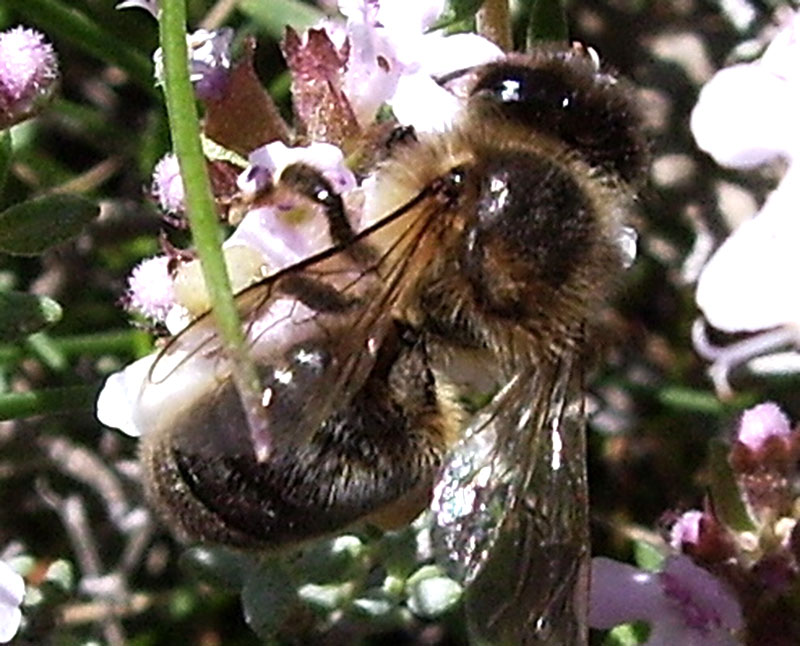
Honeybees routinely face pathogens, parasites, pesticides and more. And, as if those weren’t enough, some new troubles loom ahead. Appearing in the journal Science of the Total Environment, some new research suggests we should add climate change to the beleaguered bee’s enemies list.
To understand why, first consider the natural link between local weather conditions and overall honeybee health, honey production and honey characteristics. Just-right growing seasons can provide ideal temperatures and rainfall, which help boost the amount, quality, and duration of forage. With ample access to pollen and nectar, bees quickly establish stores and produce plenty of healthy brood. The result is a thriving—and heavy!—hive, with individual Langstroth supers weighing 40 pounds or more.
Extreme Consequences
But what if “just-right” seasons increasingly are replaced with extreme and unpredictable weather, as climate scientists predict? How would honeybees respond to consistent decreases in the amount and quality of available vegetation? To find out, University of Córdoba researchers monitored Spanish honeybees (Apis mellifera iberiensis) within the temperate Mediterranean climate zone during the flowering seasons of 2016 and 2017.
While both years featured unusually high temperatures, 2017 was the hottest year on record. It was also the second driest year in the region. After tracking adult bee population numbers as well as the amounts of brood, pollen, honey stores and more, the researchers noted many of these variables took significant hits between 2016 and 2017. Honey quality was also negatively affected.
Weight Watchers
Because overall hive weight offers clues about the health and activities of the bees inside, weight measurement was integral to the study. To gather data with minimal disruption to the bees, the researchers relied on “precision beekeeping”—a non-invasive, tech-based data collection method. For both periods studied, all hives were placed on scales. Researchers automatically recorded weight measurements and uploaded them to a remote database every 15 minutes.
The researchers also visually inspected each hive at the beginning, middle and end of 2016 and 2017 flowering periods. During inspections, they checked queen health and measured surface amounts of bee brood, pollen and honey stores. They also estimated the total number of adult bees in each colony first by weighing bee-covered comb and then subtracting the weight of the same comb sans bees.

The Big Picture
Rainfall was more frequent in 2016, so sources of nectar and pollen were readily available. During that flowering period, the hives showed an average weight increase of about 42 pounds. But during drought-stricken 2017, vegetation was more scarce. Because fewer sources of nectar and pollen were present for collection, the 2017 hives were lighter. These had an average weight increase of just less than 17 pounds.
Adding insult to injury, when new pollen is in short supply, bees must turn to older pollen stores. These can lose nutritional properties over time.
What’s more, older stored pollen can accumulate pesticides and other harmful environmental residues often present in beeswax, and, the study’s authors note, “When the bees have to use the oldest pollen, residues may return to … circulation, becoming an added threat to the survival of bees.”
Aside from weight measurements, visual inspections of the hives confirmed reduced brood and pollen stores for 2017 compared with the previous year. 2017 also saw a reduced number of total numbers of adult honeybees for 2017. Noting the significance of this finding, the researchers explain, “Colonies with lower adult bee populations are less likely to survive in unfavorable conditions.”
Honey Headaches
Extreme weather events also affected the quality of the bees’ honey—and the honey’s sale price. The researchers analyzed the pollen spectrum of the honey varieties gathered from 2016 and 2017, respectively. Although Eucalyptus pollen was the predominant pollen source for both years, 2016’s honey contained 81 percent Eucalyptus pollen. The 2017 crop included only 66 percent. In place of that missing Eucalyptus pollen? “Pollen from [the borage and rose] families increased, as they respond better to drought conditions,” the researchers write.
Because the percentage of Eucalyptus pollen contained in the 2016 honey samples met a legal threshold, beekeepers could sell it at a premium as “Eucalyptus unifloral honey.” However, the 2017 sample wasn’t uniform enough to market as anything but a lower priced “multifloral” honey.
The paper, titled “Effect of the climate change on honey bee colonies in a temperate Mediterranean zone assessed through remote hive weight monitoring system in conjunction with exhaustive colonies assessment,” is scheduled to publish in Science of the Total Environment later this month.




